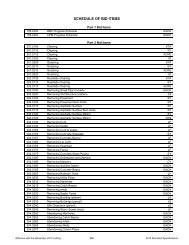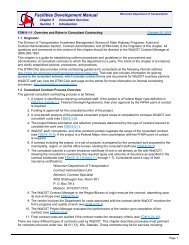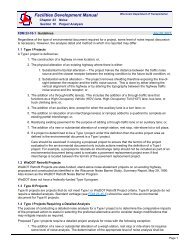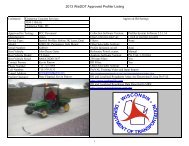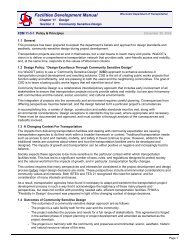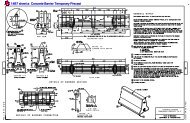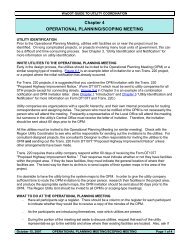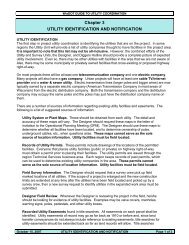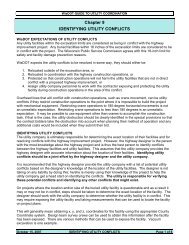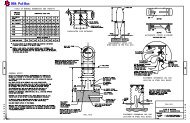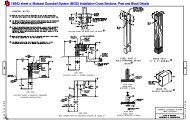Chapter 20 Conflicts During Construction - Wisconsin.gov
Chapter 20 Conflicts During Construction - Wisconsin.gov
Chapter 20 Conflicts During Construction - Wisconsin.gov
Create successful ePaper yourself
Turn your PDF publications into a flip-book with our unique Google optimized e-Paper software.
WisDOT GUIDE TO UTILITY COORDINATION<br />
accommodate the newly discovered conflict. The total costs and the time involved should be<br />
considered when making this decision. This solution only makes sense when the contractor has no<br />
other work to do and cannot wait for a delay, safety is a concern, or the public is intolerably<br />
inconvenienced.<br />
UNEXPECTED FIELD CONDITIONS<br />
This may occur when changes have been made to the topography since the survey work was done. A<br />
good example is a utility pole that was outside of the slope intercepts on the plan and therefore was not<br />
relocated because it was believed that there was no conflict. However, during construction it is<br />
discovered that a property owner altered the original terrain a few years ago and now the grading limits<br />
are such that the pole is in conflict. Or maybe drainage conditions are different than was anticipated,<br />
and a relocation is now required.<br />
In this case, no one is at fault. The utility relocated according to the information that was provided to<br />
them. The designers used the information that was provided to them. For some reason, actual field<br />
conditions are now different than what was used for the design and changes must be made.<br />
If you need the utility relocated, or exposed to determine if there is a conflict, you must contact the<br />
person from the utility company listed on the plan, or the person that attended the preconstruction<br />
meeting. If they aren’t available, ask if there is anyone that can help you. If you are unable to make a<br />
satisfactory contact, and the problem cannot wait until the appropriate person is back in the office,<br />
contact the Region Utility Coordinator. While they cannot do anything about the people who are out of<br />
the office, they may have a suggestion as to whom else to call.<br />
When you make contact with someone, explain that you have a conflict with one of their facilities<br />
because of a change in field conditions and that it needs to be relocated or exposed, whichever the<br />
case may be. Request a timeframe from them of when the work can be done. If the time seems<br />
unreasonable, ask if it can be expedited. It may be helpful to request a field meeting to discuss the<br />
situation.<br />
INCORRECTLY MARKED FACILITIES<br />
This problem is more serious. It can cause an extremely dangerous situation that may lead to injury<br />
and/or costly delays. The owner of a utility facility is responsible for accurately locating their facilities in<br />
the field. Sometimes this locating work is contracted out to various companies, but the ultimate<br />
responsibility lies with the utility.<br />
If you discover that a buried utility line has been incorrectly marked, document the markings and the<br />
facility location. Take photographs with a 6-foot rule indicating the scale if possible. At a minimum<br />
draw a sketch with appropriate dimensions showing the markings and the facility. This information<br />
should be placed in the project diary and the project files.<br />
The utility must be notified immediately. It is best to have one of their employees view the site before<br />
any markings are destroyed. They can verify the documentation you provide. If a utility line is<br />
damaged by construction activities because of the mis-marking, the utility should not be billing the<br />
contractor. The contractor should not be held liable, unless he was digging with power equipment<br />
within 18 inches of the markings (See ss.182.0175 – Figure 1-1). The utility should bear the cost of the<br />
repairs or may seek compensation from their locating service.<br />
This situation frequently requires immediate action and may be treated as an emergency. You should<br />
start by contacting the utility person on the plan, but if they are unavailable, talk to anyone from the<br />
utility and explain the situation. They should be able to put you in touch with the proper people within<br />
the utility. If you are unable to contact anyone at the utility, contact the Region Utility Coordinator or<br />
Region Permit Coordinator for assistance on how to proceed.<br />
September 30, <strong>20</strong>06 CONFLICTS DURING CONSTRUCTION Page 4 of 6




